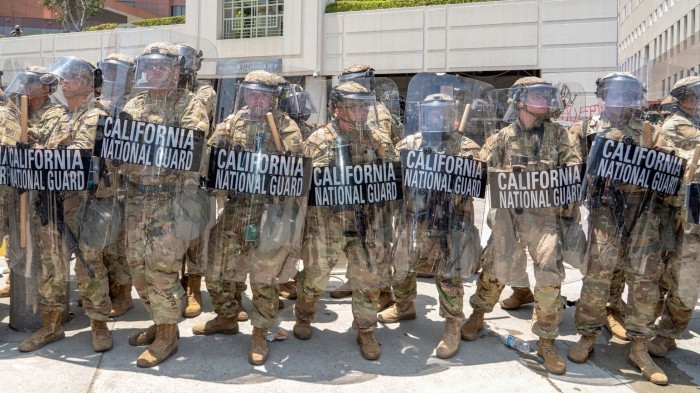Unlock the White House Watch newsletter for free
Your guide to what Trump’s second term means for Washington, business and the world
The writer is editor at large of The American Prospect and the former executive editor of LA Weekly
History sometimes needs a push. In sending his immigration police to disrupt Los Angeles, US President Donald Trump recognises this. He can now use the predictable backlash to seize more power.
Trump’s administration already stands out historically for aggregating powers to itself that the US constitution explicitly vests in Congress. The constitution does empower the president to employ the army domestically, but only if he declares the nation to be in a state of insurrection, as Abraham Lincoln did in the 1860s. The last time the Insurrection Act was invoked without a state governor’s consent was by Lyndon Johnson in 1965 to protect civil rights marchers in Alabama.
On Sunday, Trump spoke about the insurrection ostensibly under way. At the time, the protesters in California numbered fewer than 200 — objecting to federal immigration agents rounding up allegedly undocumented immigrants. Trump, however, had already put California’s national guard under his command so he could deploy them.
The president has repeatedly claimed that the agents are arresting convicted felons and gang members, although the numbers belie that claim. On Friday, agents swept through downtown Los Angeles’ fashion district, where the immigrant workforce is largely composed of seamstresses. On Saturday, they swarmed a Home Depot store in a Latino working-class suburb, targeting immigrant day labourers seeking construction jobs.
The resulting protest hardly constituted a riot. I covered the 1992 riot that rocked Los Angeles after the acquittal of police officers who had brutally beaten a Black man, Rodney King. That riot rolled on for the better part of a week, destroying hundreds of buildings and causing more than 50 deaths. California’s governor ultimately deployed the state’s national guard to help end it.
By contrast, the weekend’s initial protest was confined to one city block, there wasn’t major damage to buildings and there were just a few injuries, including a union leader and a British photographer. But history also needed a push, Trump seems to have concluded. So he used it as a pretext to send in 2,000 national guard soldiers, over the objections of California Governor Gavin Newsom, who stated that Trump is “hoping for chaos”.
If Trump had ordered his immigration enforcers to arrest some of the agricultural workers that abound in Republican-led southern states, it probably wouldn’t have provoked much pushback. But Los Angeles is a city that’s home to millions of immigrants and their children. Latinos and Asians constitute more than half of LA County’s nearly ten million residents. They are at the centre of the economy and deporting them destabilises families, businesses, and the city at large.
Trump knows that. So does Stephen Miller, his policy tsar, who grew up in nearby Santa Monica. It’s Miller who is directing Trump’s war on immigrants, which he and his boss are now using to goad California’s elected officials into defying them. That’s just what Newsom and Los Angeles Mayor Karen Bass are doing: Newsom is going to court seeking to halt Trump’s deployment of the Guard. Bass, in urging protesters to be non-violent, reminded them that police are observing a 1979 order that forbids them from aiding deportation efforts.
By provoking a showdown with California’s overwhelmingly Democratic elected officials, Trump plainly hopes to demonise them and mobilise his Maga legions to vote in next year’s midterm elections. His political career has depended on ginning up sufficient rage among his followers that they’ll support even his most extreme actions. That now requires labelling immigration as an “invasion”, and protests as an “insurrectionist mob”.
The administration chose to send its immigration enforcers to places sure to erupt at their sweeps, and then sent in the National Guard to guarantee that enraged Angelenos would expand their protests beyond the sites where the original arrests were made. They are now using those expanded protests to justify mobilising the army, with Pete Hegseth, the defence secretary, threatening to send active duty Marines.
America has been here before. In the 1850s, the Southern-dominated federal government enacted the Fugitive Slave Act, compelling northerners to co-operate with slave hunters and federal troops trying to capture escaped slaves. Several northern states passed laws forbidding such recaptures, much as California and LA have passed laws forbidding their police from enforcing immigration laws.
The Fugitive Slave Act was among the factors that led to the US civil war. The current stand-off seems unlikely to lead to outright conflict but by imposing his xenophobic agenda in California, a region of the country deeply opposed to it, Trump risks bringing the nation’s temperature to a boiling point. The agent provocateur president appears determined to keep pushing history along.
